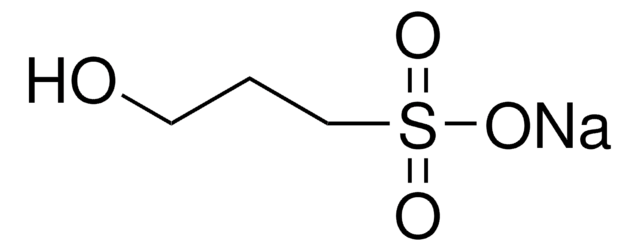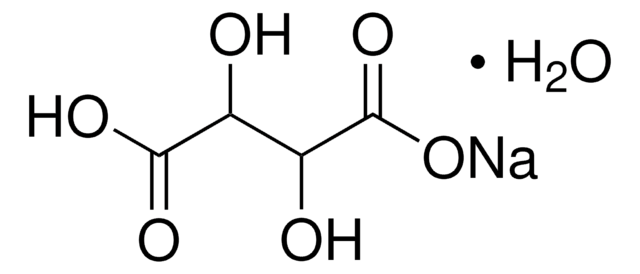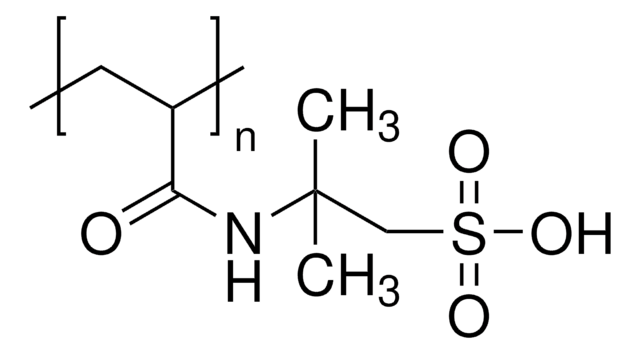모든 사진(1)
About This Item
Linear Formula:
HOOCCH2CH(SO3H)COOH
CAS Number:
Molecular Weight:
198.15
Beilstein:
1727687
MDL number:
UNSPSC 코드:
12162002
PubChem Substance ID:
NACRES:
NA.23
추천 제품
양식
viscous liquid
Quality Level
농도
70 wt. % in H2O
refractive index
n20/D 1.449
density
1.438 g/mL at 25 °C
SMILES string
OC(=O)CC(C(O)=O)S(O)(=O)=O
InChI
1S/C4H6O7S/c5-3(6)1-2(4(7)8)12(9,10)11/h2H,1H2,(H,5,6)(H,7,8)(H,9,10,11)
InChI key
ULUAUXLGCMPNKK-UHFFFAOYSA-N
유사한 제품을 찾으십니까? 방문 제품 비교 안내
애플리케이션
- Modification of nanocellulose membrane by impregnation method with sulfosuccinic acid for direct methanol fuel cell applications: This study examines the use of sulfosuccinic acid in various concentrations to improve the properties of nanocellulose membranes for fuel cells (Sriruangrungkamol & Chonkaew, 2021).
- A high-strength polyvinyl alcohol hydrogel membrane crosslinked by sulfosuccinic acid for strontium removal via filtration: Research focusing on using sulfosuccinic acid to enhance polyvinyl alcohol hydrogel membranes for effective strontium filtration (Yoon et al., 2019).
- Cross-linked poly (vinyl alcohol)/sulfosuccinic acid polymer as an electrolyte/electrode material for H2–O2 proton exchange membrane fuel cells: This paper discusses the application of sulfosuccinic acid in creating cross-linked polyvinyl alcohol for fuel cell membranes (Ebenezer et al., 2016).
- Preparation of chitosan/polyvinyl alcohol blended films containing sulfosuccinic acid as the crosslinking agent using UV curing process: An investigation into using sulfosuccinic acid to crosslink chitosan/polyvinyl alcohol films for improved mechanical properties (Yun et al., 2017).
- Investigation on resistive humidity sensing in sulfosuccinic acid doped polyaniline films: This research explores the potential of sulfosuccinic acid doped polyaniline films for humidity sensing applications (Biswas et al., 2021).
신호어
Danger
유해 및 위험 성명서
Hazard Classifications
Eye Dam. 1 - Skin Corr. 1B
Storage Class Code
8A - Combustible corrosive hazardous materials
WGK
WGK 3
Flash Point (°F)
Not applicable
Flash Point (°C)
Not applicable
이미 열람한 고객
Kenzo Hiraoka
Journal of mass spectrometry : JMS, 39(4), 341-350 (2004-04-23)
A new liquid chromatography/mass spectrometry interface, the laser spray, has been developed. Explosive vaporization and mist formation occur when an aqueous solution effusing out from the tip of the stainless-steel capillary is irradiated from the opposite side of the capillary
P Loan Honeywell-Nguyen et al.
Biochimica et biophysica acta, 1573(2), 130-140 (2002-10-26)
Elastic vesicles are the most novel development in vesicular systems design for dermal and transdermal drug delivery. However, interactions between these vesicles and human skin are not yet fully understood. In this study, the in vivo and in vitro interactions
Vishal Govind Rao et al.
Spectrochimica acta. Part A, Molecular and biomolecular spectroscopy, 102, 371-378 (2012-12-12)
Understanding ion transport dynamics, structure of surfactant aggregates in ionic liquids or ionic liquid/water solutions are quite interesting and potentially important due to widespread applications of surfactant-based systems. In this manuscript we have investigated the effect of 1-butyl-3-methylimidazolium tetrafluoroborate (bmimBF(4))
Permanent enzyme microencapsulation in reverse micellar media.
L Robledo et al.
Annals of the New York Academy of Sciences, 750, 89-93 (1995-03-31)
B A Simmons et al.
Journal of the American Chemical Society, 123(10), 2414-2421 (2001-07-18)
Dry reverse micelles of the anionic twin-tailed surfactant bis(2-ethylhexyl) sulfosuccinate (AOT) dissolved in nonpolar solvents spontaneously form an organogel when p-chlorophenol is added in a 1:1 AOT:phenol molar ratio. The solvents used were benzene, toluene, m-xylene, 2,2,4-trimethylpentane (isooctane), decane, dodecane
자사의 과학자팀은 생명 과학, 재료 과학, 화학 합성, 크로마토그래피, 분석 및 기타 많은 영역을 포함한 모든 과학 분야에 경험이 있습니다..
고객지원팀으로 연락바랍니다.











